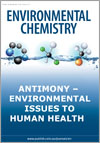
Environmental Chemistry
Volume 13 Number 6 2016
RESEARCH FRONT: Antimony – Environmental Issues to Human Health
EN16028Analysis of antimony species – lessons learnt from more than two decades of environmental research
Environmental context. The environmental behaviour and toxicological effects of antimony depend strongly on the specific form of the element, and thus methods have been developed for measuring the various forms of antimony. These methods, applicable to quite clean samples, often fail when applied to more complex environmental samples. We discuss some of the pitfalls in determining environmental antimony forms and the resulting risk of getting the bigger picture wrong regarding antimony pollution.
EN16018A novel method to determine trimethylantimony concentrations in plant tissue
Environmental context. Antimony enters the soil mostly through mining and shooting activities and can thereafter be taken up by plants. In the soil, antimony may undergo several transformations such as biomethylation, leading to the formation of trimethylantimony. Here, we measured for the first time the uptake and translocation of trimethylantimony in a plant using a new extraction and analysis method.
EN16013Soluble secondary minerals of antimony in Pezinok and Kremnica (Slovakia) and the question of mobility or immobility of antimony in mine waters
Environmental context. Antimony enters the environment from tailings and mines but there are widely divergent statements about its mobility in the environment. This work addresses the question of mobility of Sb by a combination of mineralogical and geochemical studies.
EN16054Homogeneous oxidation of SbIII by aqueous O2: the effect of ionic strength, Pb2+ and EDTA
Environmental context. Why does antimony become mobile faster in shooting range soils than in laboratory settings? We used controlled experiments and found that increased salinity and the presence of lead (which occurs with antimony at shooting ranges because they are both used in bullets) accelerate the change of antimony to a form that moves more easily through the watershed. This work helps explain the behaviour of this important pollutant – antimony – in the environment.
EN16029Role of microbial reducing activity in antimony and arsenic release from an unpolluted wetland soil: a lab scale study using sodium azide as a microbial inhibiting agent
Environmental context. Antimony and arsenic are toxic elements occurring naturally in the environment. We found that arsenic release to water from an unpolluted wetland soil is related to microbial reducing activity only, whereas antimony can still be released when this activity is inhibited, suggesting the involvement of additional processes. The findings show that microbial/non-microbial mechanisms control arsenic and antimony release and can thereby impact water quality at wetland outlets.
EN16075Cellular and molecular mechanisms of antimony transport, toxicity and resistance
Environmental context. Antimony is a toxic metalloid that is used in a wide range of modern technology applications and in medical treatments. The accelerating needs for antimony in various industrial applications has led to concerns about increased human and environmental exposure. This review provides a brief summary of the biological properties of antimony and its mechanisms of actions in cells.
EN16019Parallel responses of human epidermal keratinocytes to inorganic SbIII and AsIII
Environmental context. Increasing commercial use of antimony is raising its environmental presence and thus possible effects on humans and ecosystems. An important uncertainty is the risk that exposure poses for biological systems. The present work explores the similarity in response of human epidermal keratinocytes, a known target cell type, to antimony and arsenic, where deleterious consequences of exposure to the latter are better known.
EN16078A BUKI (Building up Knowledge Initiative) focussed on antimony’s environmental chemistry
Environmental context. Scientific knowledge is continuously built up based on research results, and relies on their efficient and accurate dissemination. Using antimony as an example, a system is proposed that combines ease of access with focussed reviews while keeping track of all published work. This system, termed BUKI (Building Up Knowledge Initiative) is a collaborative approach based on the combination of a web-based platform and the elaboration of systematic reviews.



